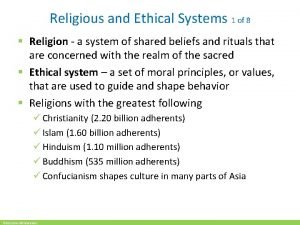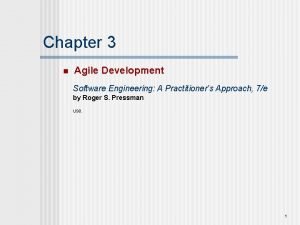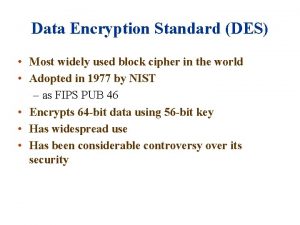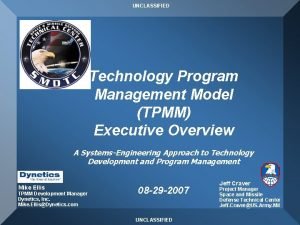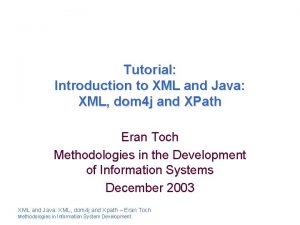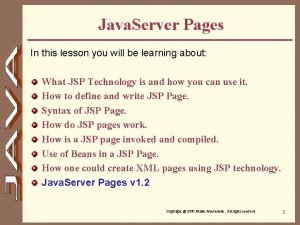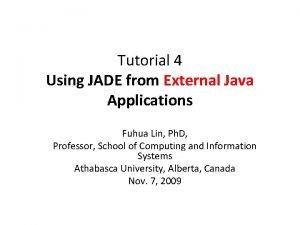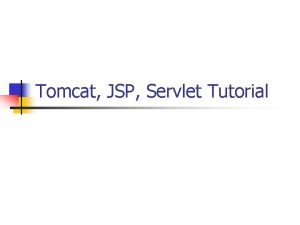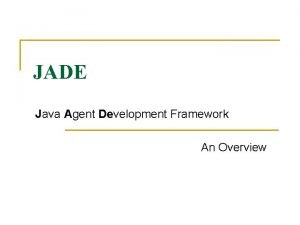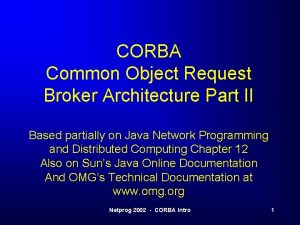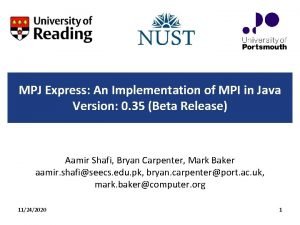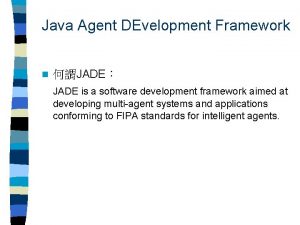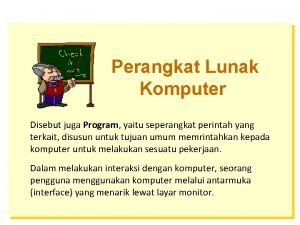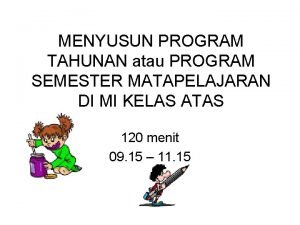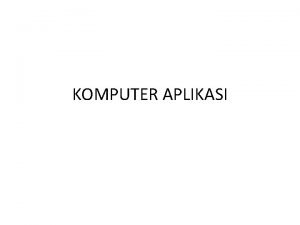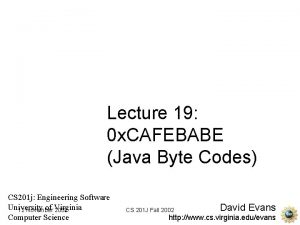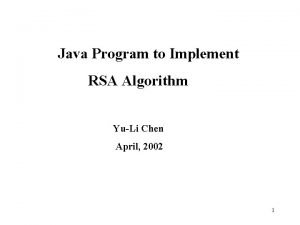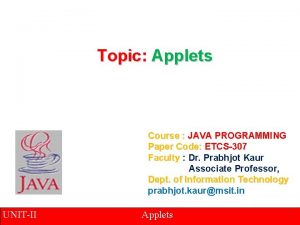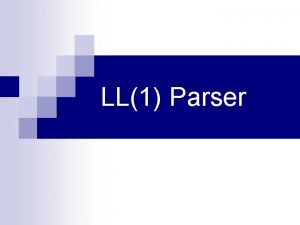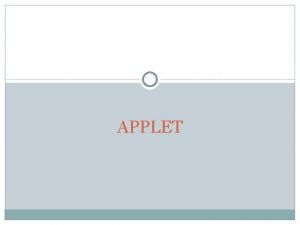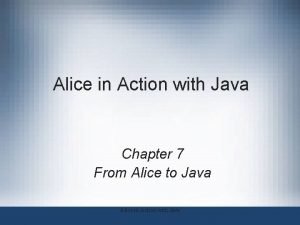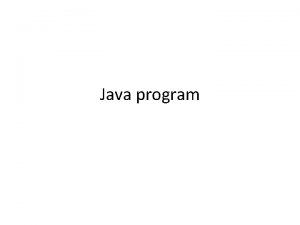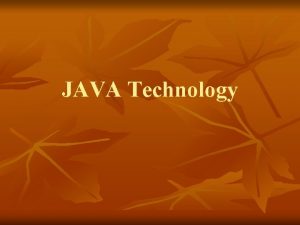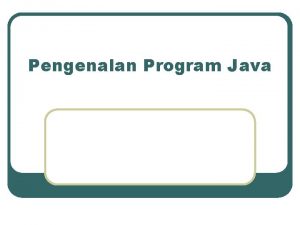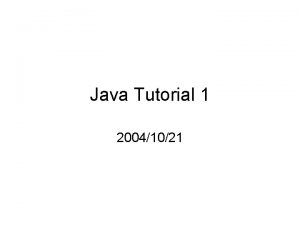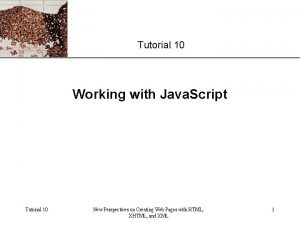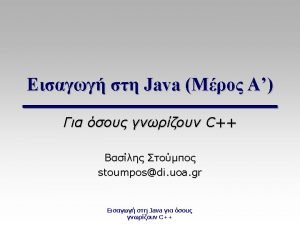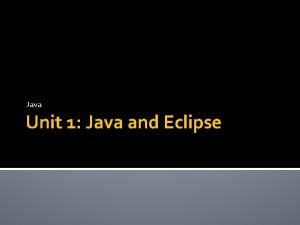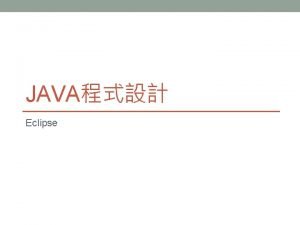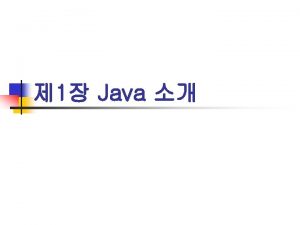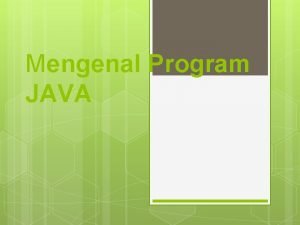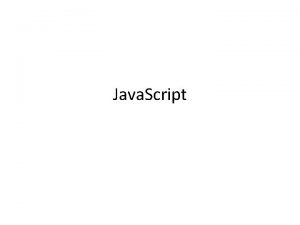Java program Java Tutorial Java technology is widely
















































- Slides: 48

Java program

Java Tutorial • Java technology is widely used currently. Let's start learning of java from basic questions like what is java, where it is used, what type of applications are created in java and why use java?

What is Java? • Java is a programming language and a platform. • Platform Any hardware or software environment in which a program runs, known as a platform. Since Java has its own Runtime Environment (JRE) and API, it is called platform.

Where it is used? According to Sun, 3 billion devices run java. There are many devices where java is currently used. Some of them are as follows: 1. Desktop Applications such as acrobat reader, media player, antivirus etc. 2. Web Applications such as irctc. co. in, etc. 3. Enterprise Applications such as banking applications. 4. Mobile 5. Embedded System 6. Smart Card 7. Robotics 8. Games etc.

Types of Java Applications There are mainly 4 type of applications that can be created using java: 1) Standalone Application It is also known as desktop application or window-based application. An application that we need to install on every machine such as media player, antivirus etc. AWT and Swing are used in java for creating standalone applications. 2) Web Application An application that runs on the server side and creates dynamic page, is called web application. Currently, servlet, jsp, struts, jsf etc. technologies are used for creating web applications in java.

Types of Java Applications(cont) 3) Enterprise Application An application that is distributed in nature, such as banking applications etc. It has the advantage of high level security, load balancing and clustering. In java, EJB is used for creating enterprise applications. 4) Mobile Application An application that is created for mobile devices. Currently Android and Java ME are used for creating mobile applications.

History of Java James Gosling Currently, Java is used in internet programming, mobile devices, games, e-business solutions etc. There are given the major points that describes the history of java. 1) James Gosling, Mike Sheridan, and Patrick Naughton initiated the Java language project in June 1991. The small team of sun engineers called Green Team. 2) Originally designed for small, embedded systems in electronic appliances like set-top boxes. 3) Firstly, it was called "Greentalk" by James Gosling and file extension was. gt. 4) After that, it was called Oak and was developed as a part of the Green project.

History of Java history is interesting to know. Java team members (also known as Green Team), initiated a revolutionary task to develop a language for digital devices such as set-top boxes, televisions etc. For the green team members, it was an advance concept at that time. But, it was suited for internet programming. Later, Java technology as incorporated by Netscape.

Why Oak name for java language? • 5) Why Oak? Oak is a symbol of strength and choosen as a national tree of many countries like U. S. A. , France, Germany, Romania etc. • 6) In 1995, Oak was renamed as "Java" because it was already a trademark by Oak Technologies.

Why Java name for java language? • 8) Java is an island of Indonesia where first coffee was produced (called java coffee). • 9) Notice that Java is just a name not an acronym. • 10) Originally developed by James Gosling at Sun Microsystems (which is now a subsidiary of Oracle Corporation) and released in 1995. • 11) In 1995, Time magazine called Java one of the Ten Best Products of 1995. • 12) JDK 1. 0 released in(January 23, 1996).

Why Java name for java language? • 7) Why they choosed java name for java language? The team gathered to choose a new name. The suggested words were "dynamic", "revolutionary", "Silk", "jolt", "DNA" etc. They wanted something that reflected the essence of the technology: revolutionary, dynamic, lively, cool, unique, and easy to spell and fun to say. • According to James Gosling "Java was one of the top choices along with Silk". Since java was so unique, most of the team members preferred java.

Java Version History • • • There are many java versions that has been released. JDK Alpha and Beta (1995) JDK 1. 0 (23 rd Jan, 1996) JDK 1. 1 (19 th Feb, 1997) J 2 SE 1. 2 (8 th Dec, 1998) J 2 SE 1. 3 (8 th May, 2000) J 2 SE 1. 4 (6 th Feb, 2002) J 2 SE 5. 0 (30 th Sep, 2004) Java SE 6 (11 th Dec, 2006) Java SE 7 (28 th July, 2011)

Features of Java • There is given many features of java. They are also known as java buzzwords. • Simple • Object-Oriented • Platform independent • Secured • Robust • Architecture neutral • Portable • Dynamic • Interpreted • High Performance • Multithreaded • Distributed

Simple According to Sun, Java language is simple because: syntax is based on C++ (so easier for programmers to learn it after C++). removed many confusing and/or rarely-used features e. g. , explicit pointers, operator overloading etc. No need to remove unreferenced objects because there is Automatic Garbage Collection in java.

Object-oriented means we organize our software as a combination of different types of objects that incorporates both data and behaviour. Object-oriented programming(OOPs) is a methodology that simplify software development and maintenance by providing some rules. Basic concepts of OOPs are: 1. Object 2. Class 3. Inheritance 4. Polymorphism 5. Abstraction 6. Encapsulation

Platform Independent • A platform is the hardware or software environment in which a program runs. There are two types of platforms software-based and hardware-based. Java provides softwarebased platform. The Java platform differs from most other platforms in the sense that it's a software-based platform that runs on top of other hardware-based platforms. It has two components:

Java code can be run on multiple platforms e. g. Windows, Linux, Sun Solaris, Mac/OS etc. Java code is compiled by the compiler and converted into bytecode. This bytecode is a platform independent code because it can be run on multiple platforms i. e. Write Once and Run Anywhere(WORA). 1. Runtime Environment 2. API(Application Programming Interface)

Secured Java is secured because: • No explicit pointer • Programs run inside virtual machine sandbox.

• Classloader- adds security by separating the package for the classes of the local file system from those that are imported from network sources. • Bytecode Verifier- checks the code fragments for illegal code that can violate access right to objects. • Security Manager- determines what resources a class can access such as reading and writing to the local disk. These security are provided by java language. Some security can also be provided by application developer through SSL, JAAS, cryptography etc.

Robust • Robust simply means strong. Java uses strong memory management. There are lack of pointers that avoids security problem. There is automatic garbage collection in java. There is exception handling and type checking mechanism in java. All these points makes java robust.

Robust • Robust simply means strong. Java uses strong memory management. There are lack of pointers that avoids security problem. There is automatic garbage collection in java. There is exception handling and type checking mechanism in java. All these points makes java robust.

Architecture-neutral • There is no implementation dependent features e. g. size of primitive types is set.

Portable • We may carry the java bytecode to any platform.

High-performance • Java is faster than traditional interpretation since byte code is "close" to native code still somewhat slower than a compiled language (e. g. , C++)

Distributed • We can create distributed applications in java. RMI and EJB are used for creating distributed applications. We may access files by calling the methods from any machine on the internet.

Multi-threaded • A thread is like a separate program, executing concurrently. We can write Java programs that deal with many tasks at once by defining multiple threads. The main advantage of multi -threading is that it shares the same memory. Threads are important for multi-media, Web applications etc.

Simple Program of Java • In this page, we will learn how to write the hello java program. We can write a simple hello java program easily. • To create a simple java program, you need to create a class that contains main method. Let's understand the requirement first.

Requirement for Hello Java Example • For executing any java program, you need to install the JDK if you don't have installed it, download the JDK and install it. • set path of the jdk/bin directory. http: //www. javatpoint. com/how-to-set-pathin-java • create the java program • compile and run the java program

Creating hello java example • Let's create the hello java program: class Simple{ public static void main(String args[]){ System. out. println("Hello Java"); } }

• • save this file as Simple. java To compile: javac Simple. java To execute: java Simple Output: Hello Java

Understanding first java program • Let's see what is the meaning of class, public, static, void, main, String[], System. out. println(). • class keyword is used to declare a class in java. • public keyword is an access modifier which represents visibility, it means it is visible to all. • static is a keyword, if we declare any method as static, it is known as static method. The core advantage of static method is that there is no need to create object to invoke the static method. The main method is executed by the JVM, so it doesn't require to create object to invoke the main method. So it saves memory.

Understanding first java program • void is the return type of the method, it means it doesn't return any value. • main represents startup of the program. • String[] args is used for command line argument. We will learn it later. • System. out. println() is used print statement. We will learn about the internal working of System. out. println statement later.

Internal Details of Hello Java Program In the previous page, we have learned about the first program, how to compile and how to run the first java program. Here, we are going to learn, what happens while compiling and running the java program. Moreover, we will see some question based on the first program.

What happens at compile time? • At compile time, java file is compiled by Java Compiler (It does not interact with OS) and converts the java code into bytecode.

What happens at runtime?

What happens at compile time? Classloader: is the subsystem of JVM that is used to load class files. Bytecode Verifier: checks the code fragments for illegal code that can violate access right to objects. Interpreter: read bytecode stream then execute the instructions.

Q)Can you save a java source file by other name than the class name? • Yes, like the figure given below illustrates:

Q)Can you have multiple classes in a java source file? • Yes, like the figure given below illustrates:

How to set path in Java • The path is required to be set for using tools such as javac, java etc. • If you are saving the java source file inside the jdk/bin directory, path is not required to be set because all the tools will be available in the current directory. • But If you are having your java file outside the jdk/bin folder, it is necessary to set path of JDK. • There are 2 ways to set java path: – temporary – permanent

1) How to set Temporary Path of JDK in Windows To set the temporary path of JDK, you need to following steps: Open command prompt copy the path of jdk/bin directory write in command prompt: set path=copied_path For Example: set path=C: Program FilesJavajdk 1. 6. 0_23bin

2) How to set Permanent Path of JDK in Windows • For setting the permanent path of JDK, you need to follow these steps: • Go to My. Computer properties -> advanced tab -> environment variables -> new tab of user variable -> write path in variable name -> write path of bin folder in variable value -> ok

Difference between JDK, JRE and JVM • Understanding the difference between JDK, JRE and JVM is important in Java. We are having brief overview of JVM here. • If you want to get the detailed knowledge of Java Virtural Machine, move to the next page. Firstly, let's see the basic differences between the JDK, JRE and JVM.

JVM (Java Virtual Machine) is an abstract machine. It is a specification that provides runtime environment in which java bytecode can be executed. JVMs are available for many hardware and software platforms. JVM, JRE and JDK are platform dependent because configuration of each OS differs. But, Java is platform independent. • The JVM performs following main tasks: Loads code • Verifies code • Executes code • Provides runtime environment

JRE is an acronym for Java Runtime Environment. It is used to provide runtime environment. It is the implementation of JVM. It physically exists. It contains set of libraries + other files that JVM uses at runtime. Implementation of JVMs are also actively released by other companies besides Sun Micro Systems.

JRE

JDK • JDK is an acronym for Java Development Kit. It physically exists. It contains JRE + development tools.

Types of Variable There are three types of variables in java – local variable – instance variable – static variable

Local Variable
 Biomedical therapies are provided by
Biomedical therapies are provided by Most widely practiced religion
Most widely practiced religion Most widely practiced religion
Most widely practiced religion Rapid diffusion of popular culture
Rapid diffusion of popular culture Self secured joints
Self secured joints The most widely used agile process originally proposed by
The most widely used agile process originally proposed by What is the sequence of installations on rhipe
What is the sequence of installations on rhipe ______ was widely-practiced in african society.
______ was widely-practiced in african society. Widely used method
Widely used method The most widely used encryption standard is
The most widely used encryption standard is Technology program management model
Technology program management model Asetlink
Asetlink Illinois assistive technology program
Illinois assistive technology program Broadband technology opportunities program
Broadband technology opportunities program El camino college radiology
El camino college radiology Small business technology transfer
Small business technology transfer Technology applications program office
Technology applications program office Technology applications program office
Technology applications program office Nasa technology transfer program
Nasa technology transfer program Java dom tutorial
Java dom tutorial Java server pages tutorial
Java server pages tutorial Swing tutorial
Swing tutorial Java jade tutorial
Java jade tutorial Socket programming tcp udp
Socket programming tcp udp Java gui tutorial
Java gui tutorial Corba java tutorial
Corba java tutorial Jsp servlet tutorial
Jsp servlet tutorial Java agent development framework
Java agent development framework Object request broker example
Object request broker example Mpj java
Mpj java Java swing tutorial
Java swing tutorial Tdd tutorial java
Tdd tutorial java Rhino java
Rhino java Java agent development framework
Java agent development framework Sequential program and an event-driven program?
Sequential program and an event-driven program? Program-program komputer disebut juga dengan
Program-program komputer disebut juga dengan Merancang program tahunan dan program semester
Merancang program tahunan dan program semester Microsoft office excel merupakan program aplikasi
Microsoft office excel merupakan program aplikasi Pengolah angka microsoft excel adalah
Pengolah angka microsoft excel adalah Ms word
Ms word Byte stuffing program in java
Byte stuffing program in java Rsa algorithm java program
Rsa algorithm java program Import scanner java
Import scanner java Java applet program draw cartoon
Java applet program draw cartoon Thread dalam java
Thread dalam java Ll1
Ll1 Java applet adalah
Java applet adalah Hard task for alice program in java
Hard task for alice program in java Empty
Empty

